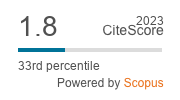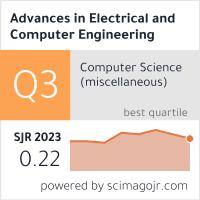| 2/2008 - 7 |
Virtual Lab for Wireless Sensor NetworksPICOVICI, D. |
| Extra paper information in |
| Click to see author's profile in |
| Download PDF |
Author keywords
moteiv, Tmote Sky, virtual clients, virtual lab wireless networks, wireless sensors
References keywords
sensor(8), link(8), networks(5), david(5)
Blue keywords are present in both the references section and the paper title.
About this article
Date of Publication: 2008-06-02
Volume 8, Issue 2, Year 2008, On page(s): 37 - 42
ISSN: 1582-7445, e-ISSN: 1844-7600
Digital Object Identifier: 10.4316/AECE.2008.02007
Web of Science Accession Number: 000264815000007
SCOPUS ID: 67749110369
Abstract
This article details an experimental system developed to enhance the education and research in the area of wireless networks technologies. The system referred, as Virtual Lab (VL) is primarily targeting first time users or users with limited experience in programming and using wireless sensor networks. The VL enables a set of predefined sensor networks to be remotely accessible and controlled for constructive and time-efficient experimentation. In order to facilitate the user's wireless sensor applications, the VL is using three main components: a) a Virtual Lab Motes (VLM), representing the wireless sensor, b) a Virtual Lab Client (VLC), representing the user's tool to interact with the VLM and c) a Virtual Lab Server (VLS) representing the software link between the VLM and VLC. The concept has been proven using the moteiv produced Tmote Sky modules. Initial experimental use clearly demonstrates that the VL approach reduces dramatically the learning curve involved in programming and using the associated wireless sensor nodes. In addition the VL allows the user's focus to be directed towards the experiment and not towards the software programming challenges. |
| References | | | Cited By «-- Click to see who has cited this paper |
| [1] Stankovic, J. A., Research Challenges for Wireless Sensor Networks, ACM Press, July 2004
[2] Ian F. Akyildiz, Weilian Su, Yogesh Sankarasubramaniam, Erdal Cayirci, A Survey on Sensor Networks, Communications Magazine, IEEE, August 2002 [3] Curt Schurgers Mani B. Srivastava, Energy efficient routing in wireless sensor networks, International Workshop on Modeling Analysis and Simulation of Wireless and Mobile Systems, October 2004 [4] Chris Karlof and David Wagner. Secure routing in wireless sensor networks: Attacks and countermeasures, In Proceedings of First IEEE International Workshop on Sensor Network Protocols and Applications, May 2003. [CrossRef] [Web of Science Times Cited 640] [SCOPUS Times Cited 1094] [5] Moteiv Corporation, San Francisco, CA, [Online] Available: Temporary on-line reference link removed - see the PDF document [6] Moteiv Corporation, TmoteSky Technical documentation, [Online] Available: Temporary on-line reference link removed - see the PDF document [7] Texas Instruments, MSP430x1xx Family User's Guide, [Online] Available: Temporary on-line reference link removed - see the PDF document [8] Moteiv Corporation, Tmote Sky datasheet, [Online] Available: Temporary on-line reference link removed - see the PDF document [9] Chipcon Corporation, Inverted F antenna datasheet, [Online] Available: Temporary on-line reference link removed - see the PDF document [10] Anghel Vasile Contiu, A virtual lab approach for wireless sensor motes and wireless sensor networks, MEng Thesis, Technical University of Cluj-Napoca, 2006 [11] David Gay, Matt Welsh, David Culler, The nesC Language: A Holistic Approach to Networked Embedded Systems, ACM Press, May 2003 [12] Philip Levis, TinyOS Programming, [Online] Available: Temporary on-line reference link removed - see the PDF document [13] Philip Levis, David Gay, Vlado Handziski, Jan-Hinrich Hauer, Ben Greenstein, Martin Turon, Jonathan Hui, Kevin Klues, Cory Sharp, Robert Szewczyk, Joe Polastre, Philip Buonadonna, Lama Nachman, Gilman Tolle, David Culler, and Adam Wolisz, TinyOS 2.0, The 3rd ACM Conference on Embedded Networked Sensor Systems (SenSys'05), November 2005 [14] MIG tool description, [Online] Available: Temporary on-line reference link removed - see the PDF document [15] Jonathan Hui, Deluge 2.0 - TinyOS Network Programming, [Online] Available: Temporary on-line reference link removed - see the PDF document Web of Science® Citations for all references: 640 TCR SCOPUS® Citations for all references: 1,094 TCR Web of Science® Average Citations per reference: 43 ACR SCOPUS® Average Citations per reference: 73 ACR TCR = Total Citations for References / ACR = Average Citations per Reference We introduced in 2010 - for the first time in scientific publishing, the term "References Weight", as a quantitative indication of the quality ... Read more Citations for references updated on 2024-12-04 16:48 in 10 seconds. Note1: Web of Science® is a registered trademark of Clarivate Analytics. Note2: SCOPUS® is a registered trademark of Elsevier B.V. Disclaimer: All queries to the respective databases were made by using the DOI record of every reference (where available). Due to technical problems beyond our control, the information is not always accurate. Please use the CrossRef link to visit the respective publisher site. |
Faculty of Electrical Engineering and Computer Science
Stefan cel Mare University of Suceava, Romania
All rights reserved: Advances in Electrical and Computer Engineering is a registered trademark of the Stefan cel Mare University of Suceava. No part of this publication may be reproduced, stored in a retrieval system, photocopied, recorded or archived, without the written permission from the Editor. When authors submit their papers for publication, they agree that the copyright for their article be transferred to the Faculty of Electrical Engineering and Computer Science, Stefan cel Mare University of Suceava, Romania, if and only if the articles are accepted for publication. The copyright covers the exclusive rights to reproduce and distribute the article, including reprints and translations.
Permission for other use: The copyright owner's consent does not extend to copying for general distribution, for promotion, for creating new works, or for resale. Specific written permission must be obtained from the Editor for such copying. Direct linking to files hosted on this website is strictly prohibited.
Disclaimer: Whilst every effort is made by the publishers and editorial board to see that no inaccurate or misleading data, opinions or statements appear in this journal, they wish to make it clear that all information and opinions formulated in the articles, as well as linguistic accuracy, are the sole responsibility of the author.





